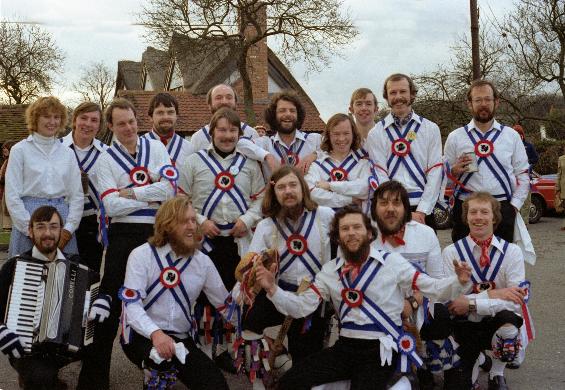
| Home... | Introducing Blackmore Morris... | Where to see us... | Photo Gallery... |
By "Morris" most people mean Cotswold Morris - the one with hankies and bells (and sticks)! The tradition of Morris dancing goes back at least 600 years (although elements of the dance may be older than this) and was danced in in London and towns and villages all over the south of England and the Midlands, but by the time the dances were written down, at the end of the 19th century and the beginning of the 20th, it was mainly danced in the villages of Oxfordshire and Gloucestershire and is now known as Cotswold Morris (to distinguish it from North-West Morris - the one with clogs, and Border Morris - the one with black faces and tatter coats, and Molly dancing - also with black faces and boots from East Anglia).
Morris dancing in Essex
There are references to Morris dancing in Essex as far back as 1527, when the Churchwardens' accounts for Dunmow refer to payment for a black Morris coat. Records show that the Morris was also danced in Maldon, where the Chamberlain's accounts for 1540 refer to payments for bells, minstrels and Morris dancers. The Barrington family of Hatfield Broad Oak made payments to Morris dancers for Christmas entertainments between 1635 and 1660. In 1599 Will Kemp, an actor at the Globe Theatre at the time of William Shakespeare famed for his dancing, set out to dance the Morris all the way from London to Norwich, through Ilford, Romford, Brentwood, Chelmsford, Braintree and Sudbury. This was known as Kemp's Nine Daies Wonder (although he took 27 days over the journey). And in his History of Dagenham (1904), J. P. Shawcross referred to Morris dancing as one of the amusements of the lower orders in the 18th century. But by the time Sharp and his friends were collecting Morris dances in the early years of the 20th century, Morris had entirely died out in Essex.
Morris revivals in the 20th century
Morris dancing was introduced to Thaxted by Miriam Noel, wife of Conrad Noel the vicar of Thaxted. In 1911 the Thaxted Morris Company consisted of a boys' team and a girls' team, but when Thaxted Morris was reformed after the First World War it was as a men's team. In 1934 the Morris Ring was formed, a federation of men's Morris clubs which has met annually at Thaxted ever since. One of the first Morris sides to be set up in Essex after the Second World War was the Benfleet Hoymen, who first danced out in the Coronation year 1953, and one of the principal instigators and founders of Blackmore Morris in 1970, Roy Tomlin, had previously danced with Benfleet Hoymen.
Morris dancing in the 21st century
Cotswold Morris may seem an anachronism in the 21st century, but when the squeeze box and fiddle start the crowds gather, the children dance too and everyone has a good time. There were only a handful of teams 50 or 60 years ago but now there are hundreds of teams in England and throughout the English-speaking world.
Morris dancers don't always take themselves seriously, though they do take the dancing seriously. It may appear a bit silly to some, but it's all the more important for that because there is something wonderfully civilised about celebratory dancing. The darker the times, the more important it is to dance. It certainly gives the lie to all that nonsense about the English being reserved and inhibited. And it makes the beer taste better.

The Old Team at The Boar's Head, Herongate, 1 January 1981
Introducing Blackmore Morris...
© Copyright Blackmore Morris 2023